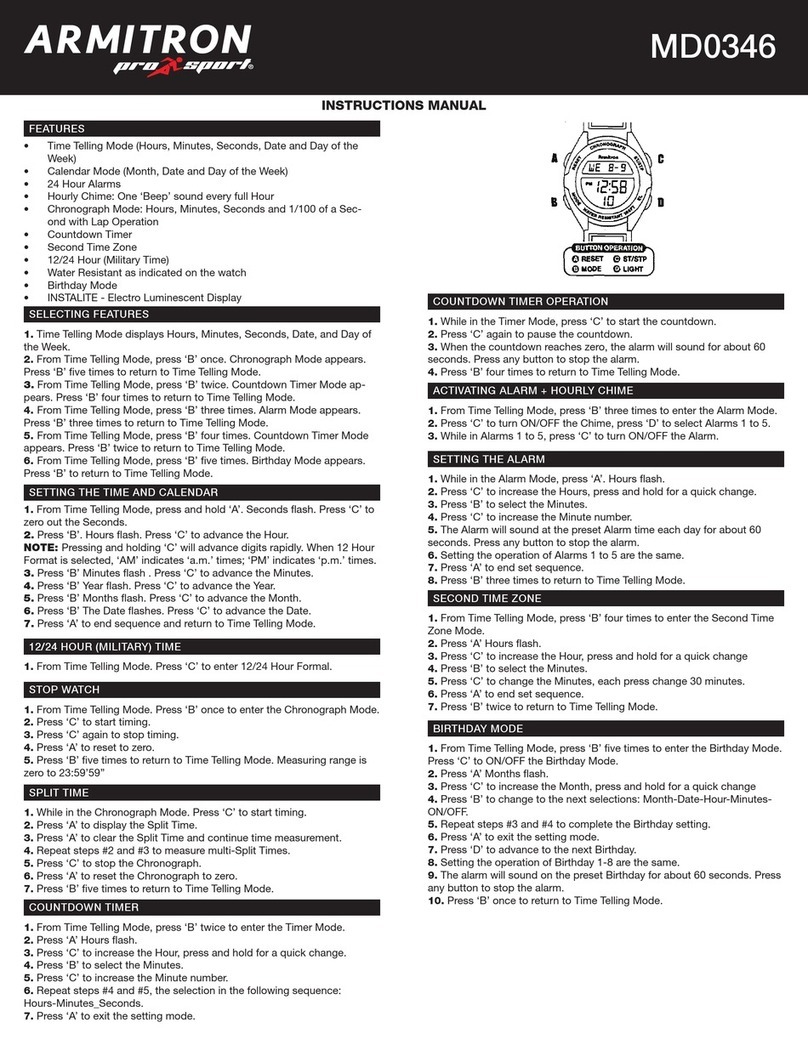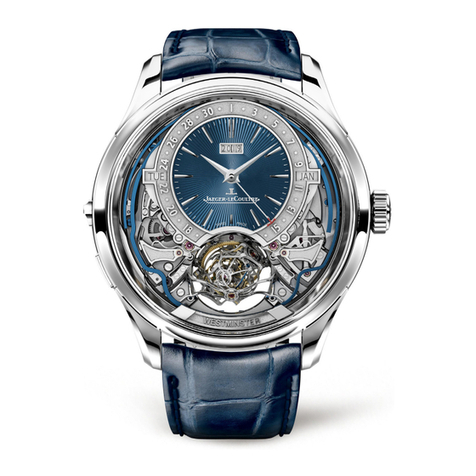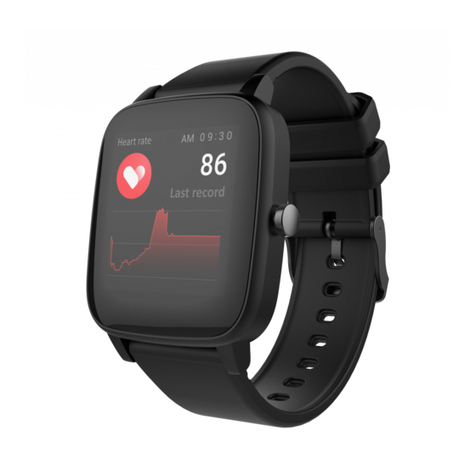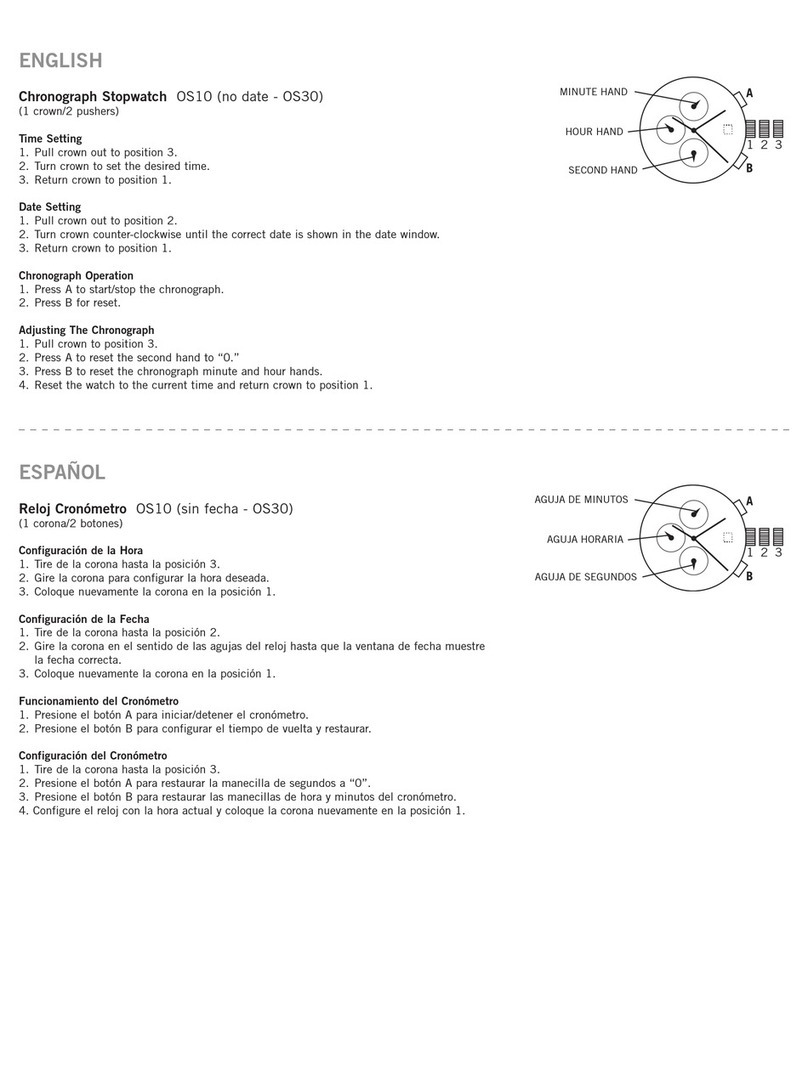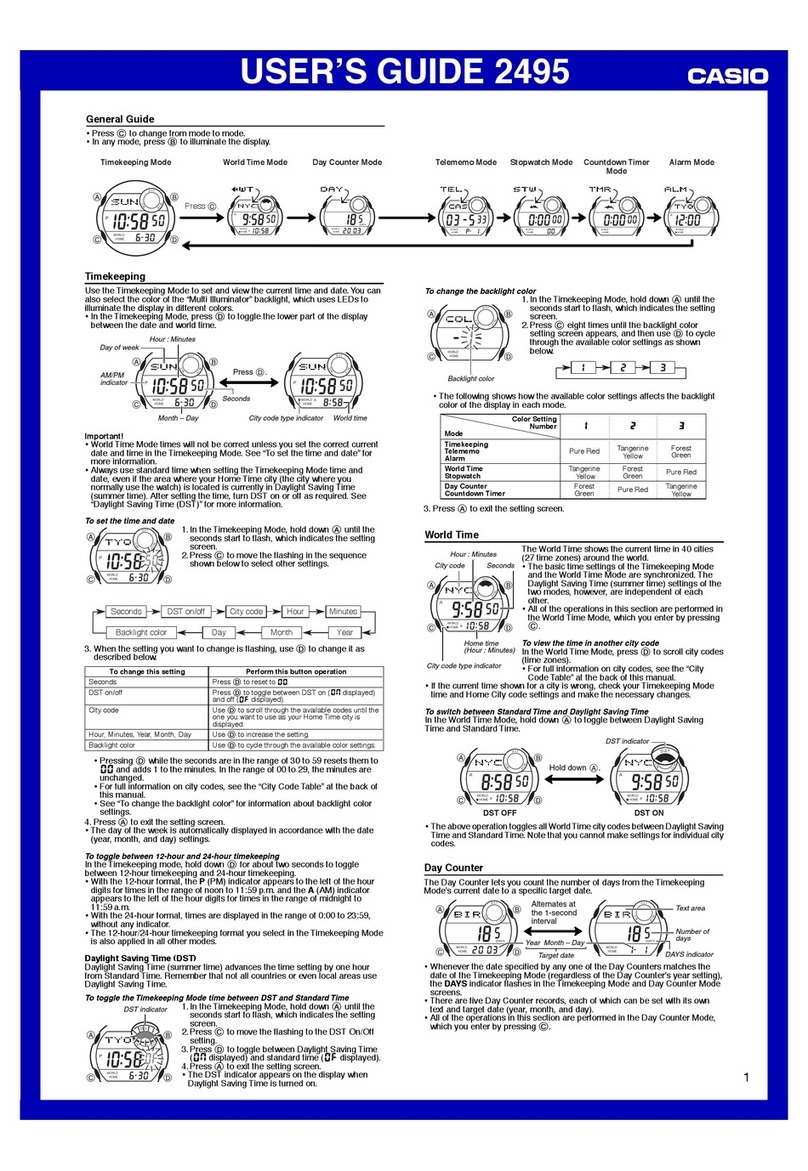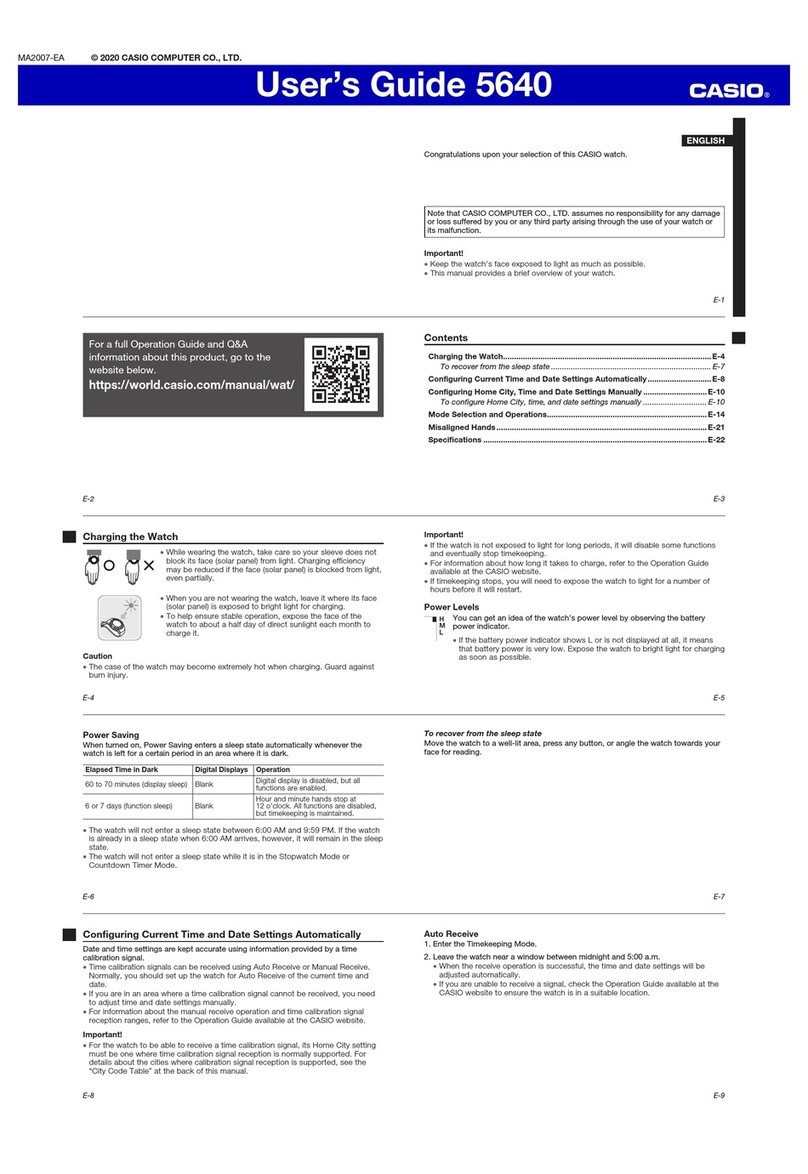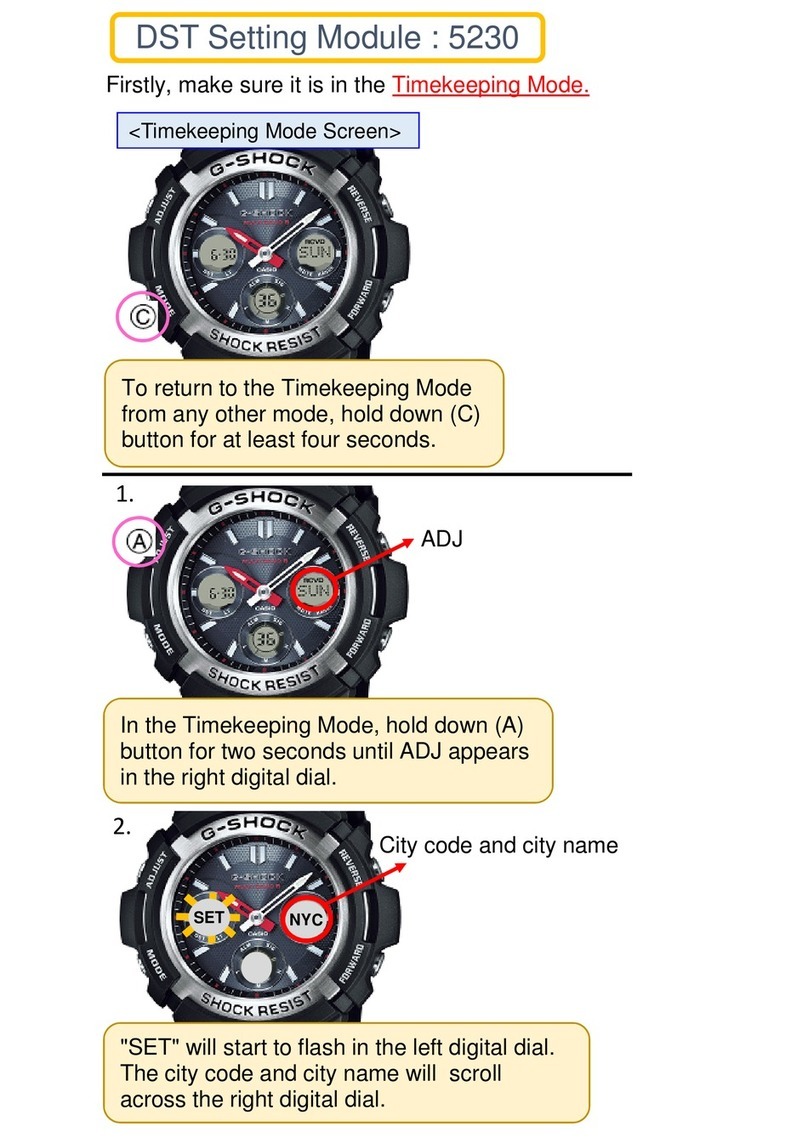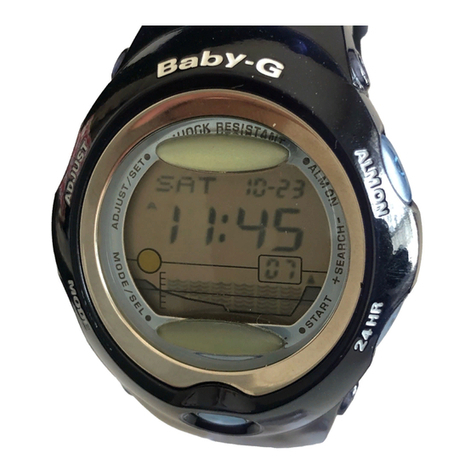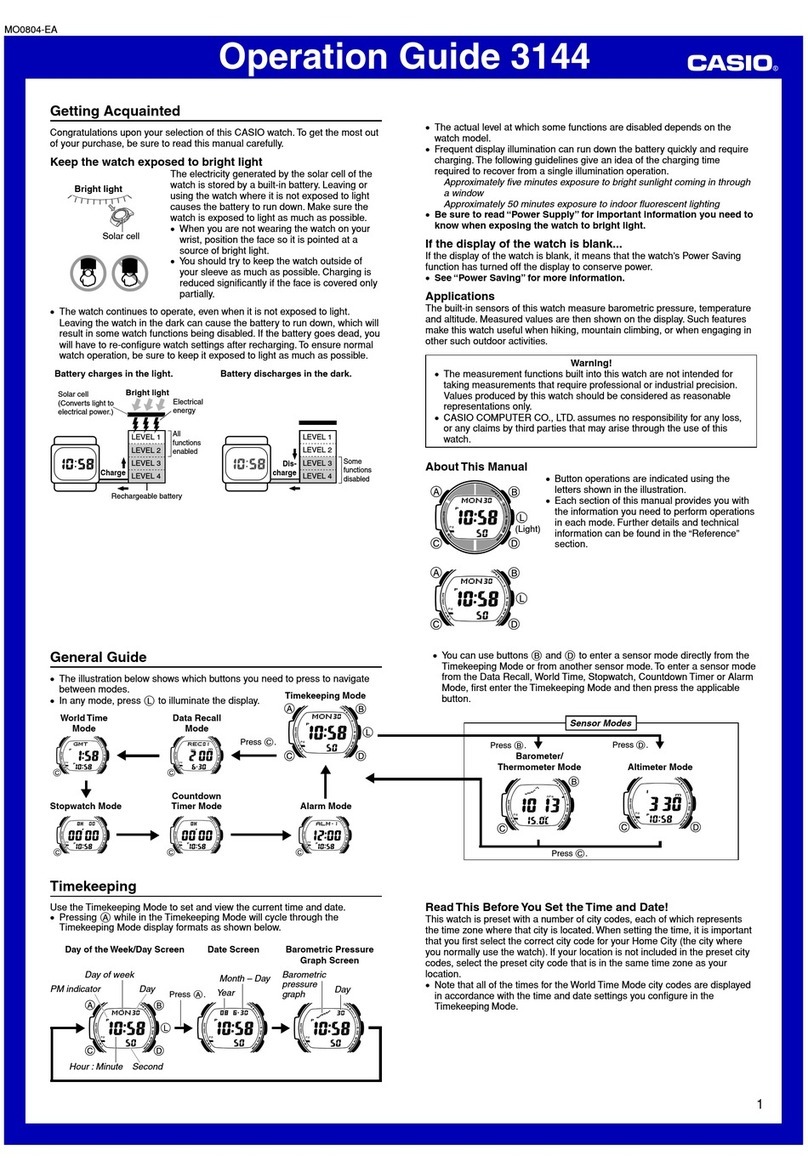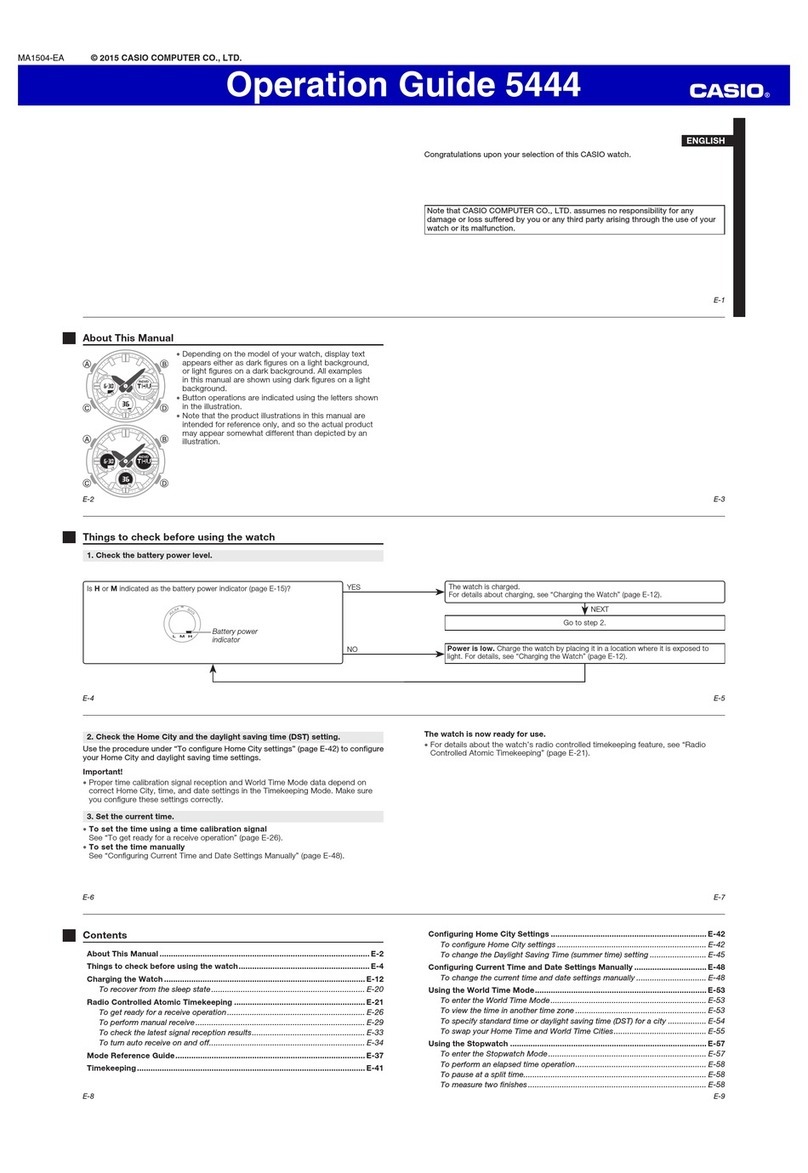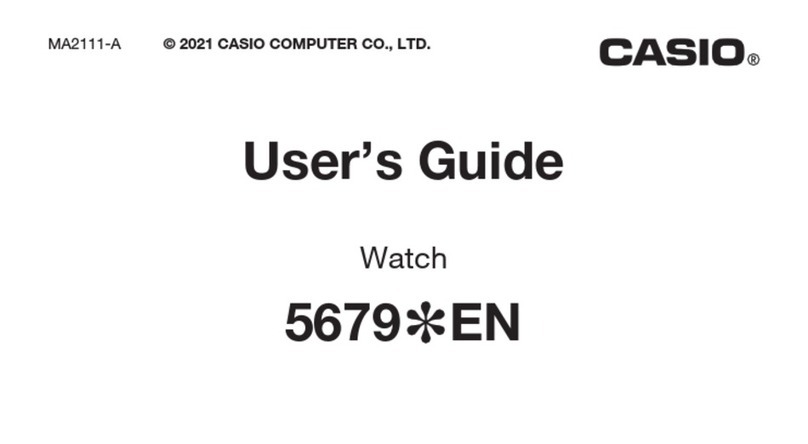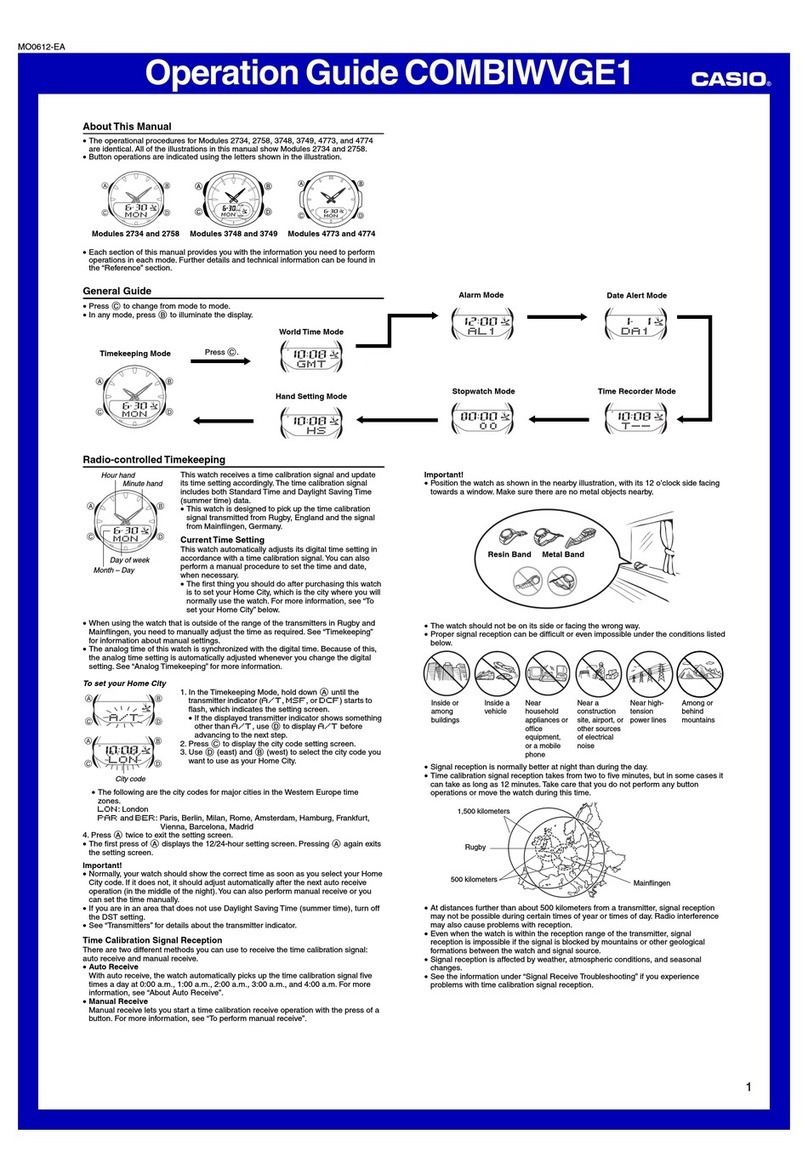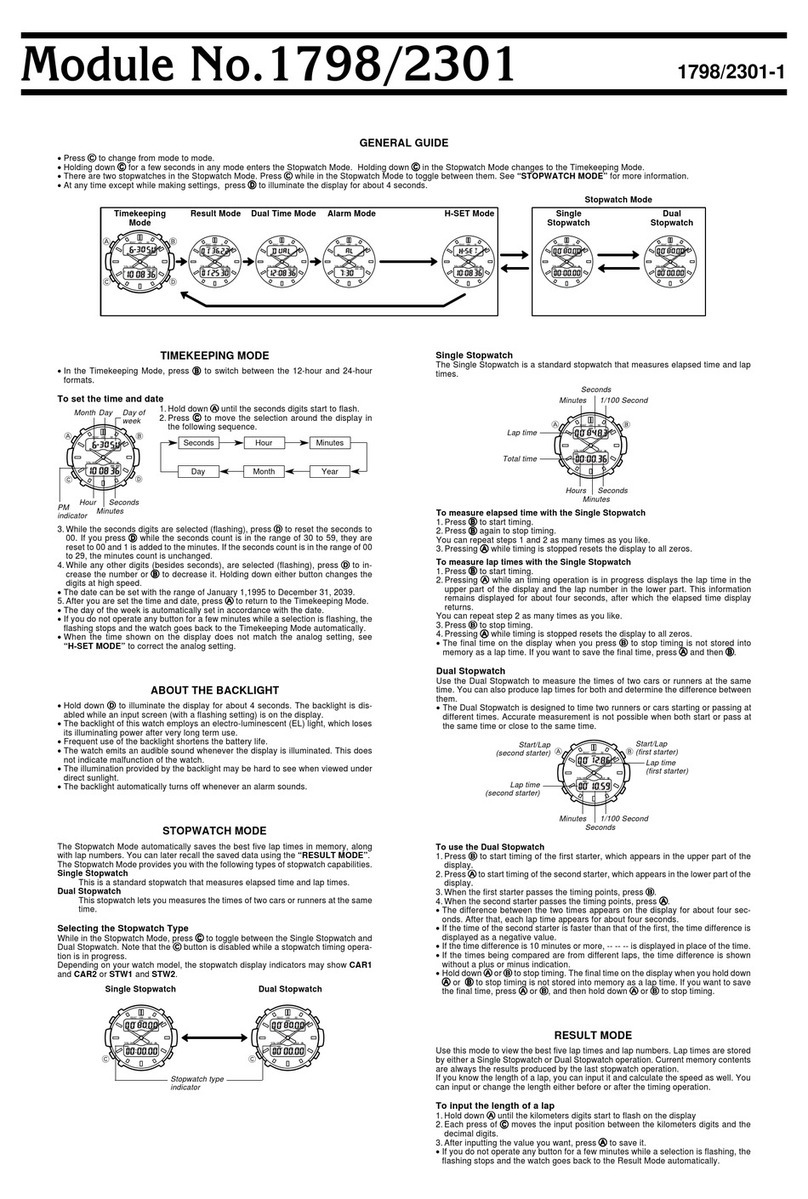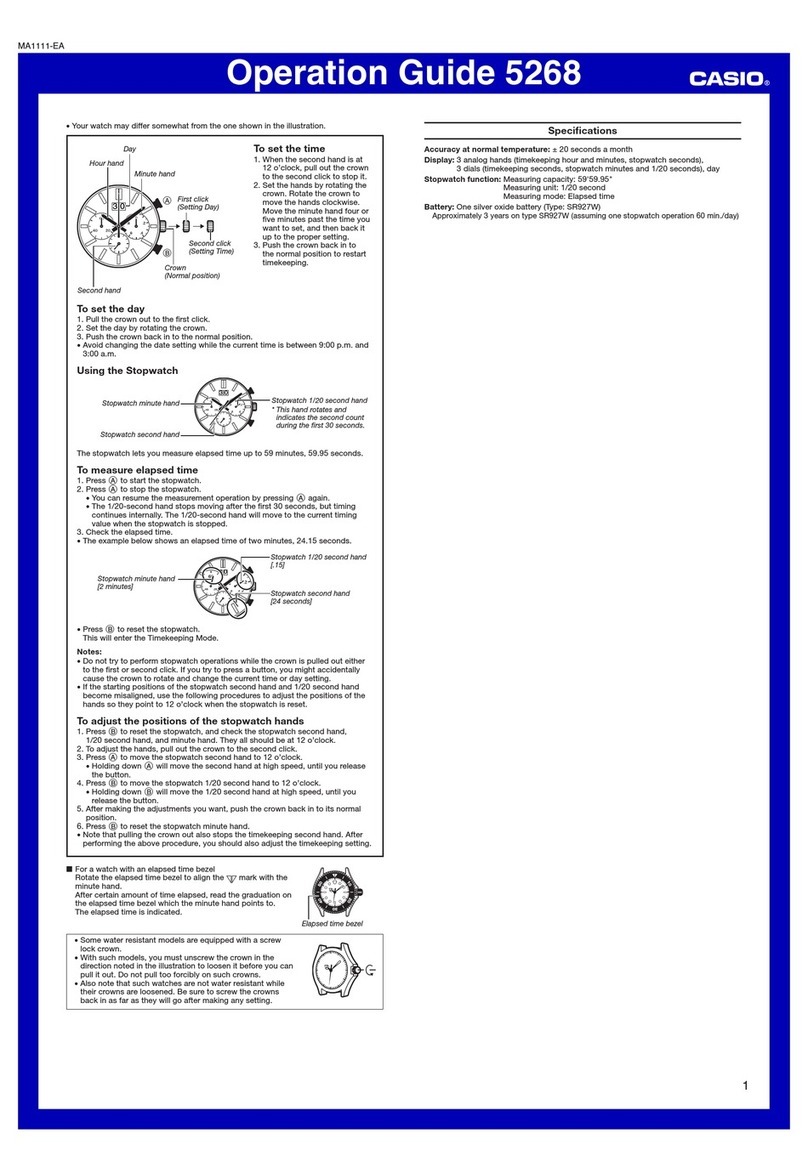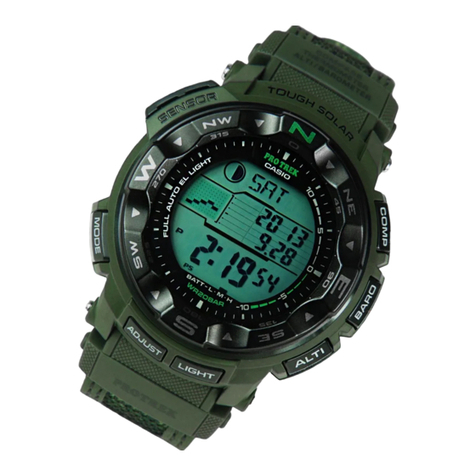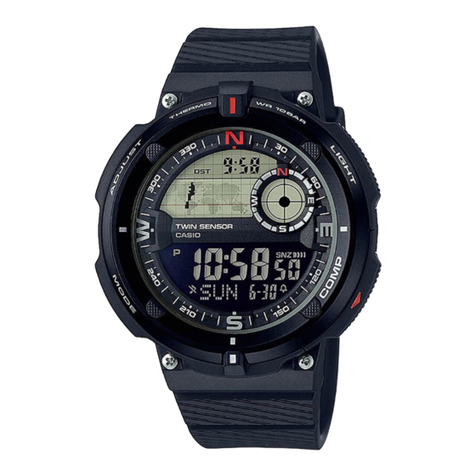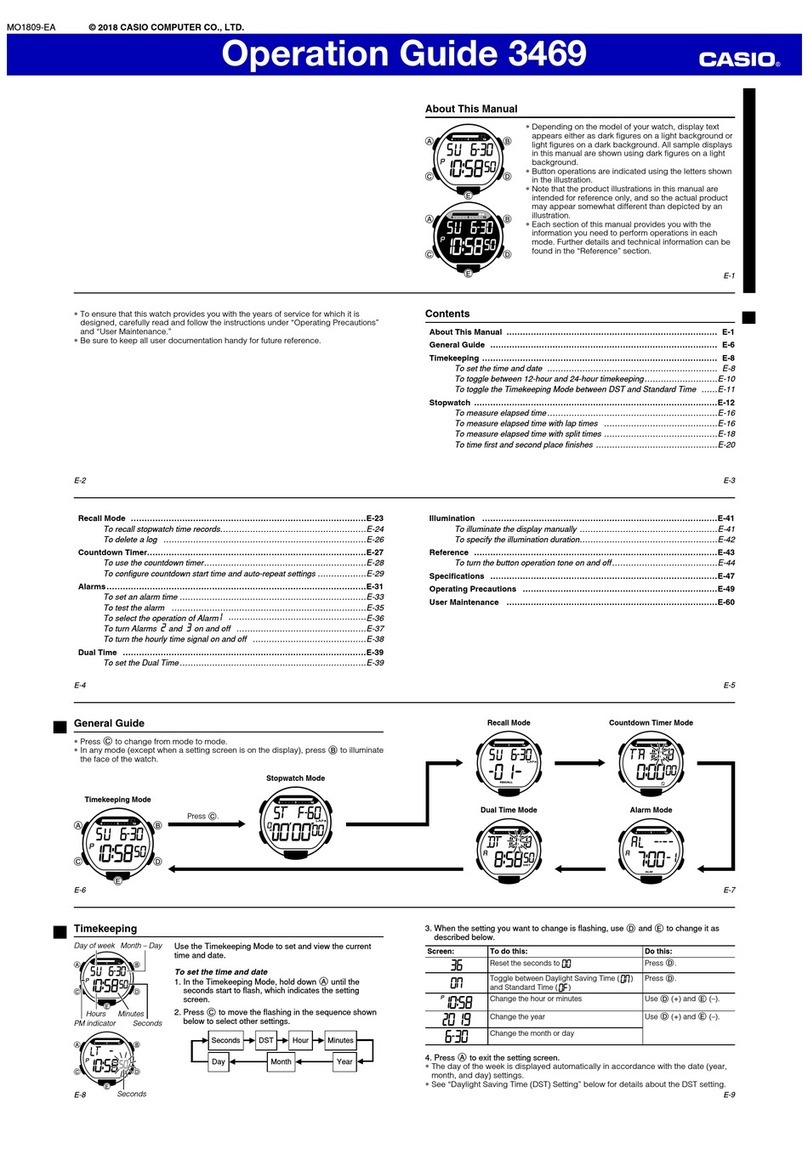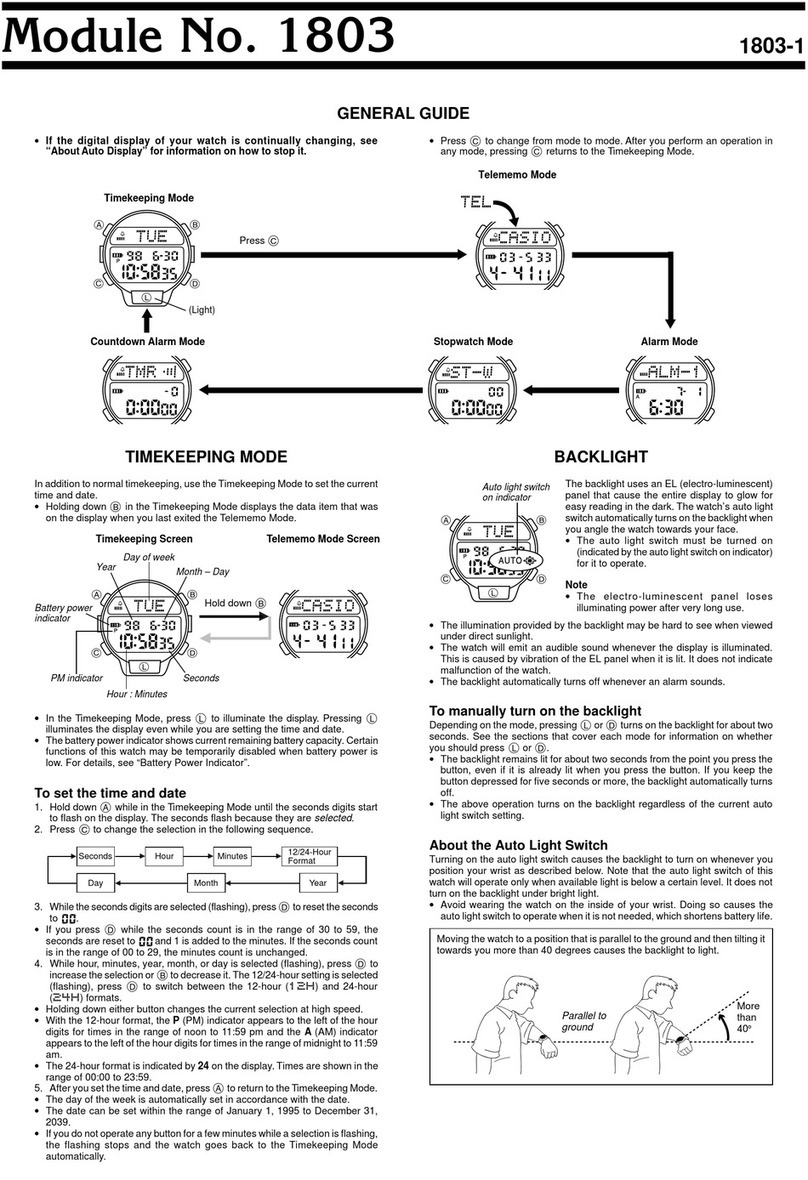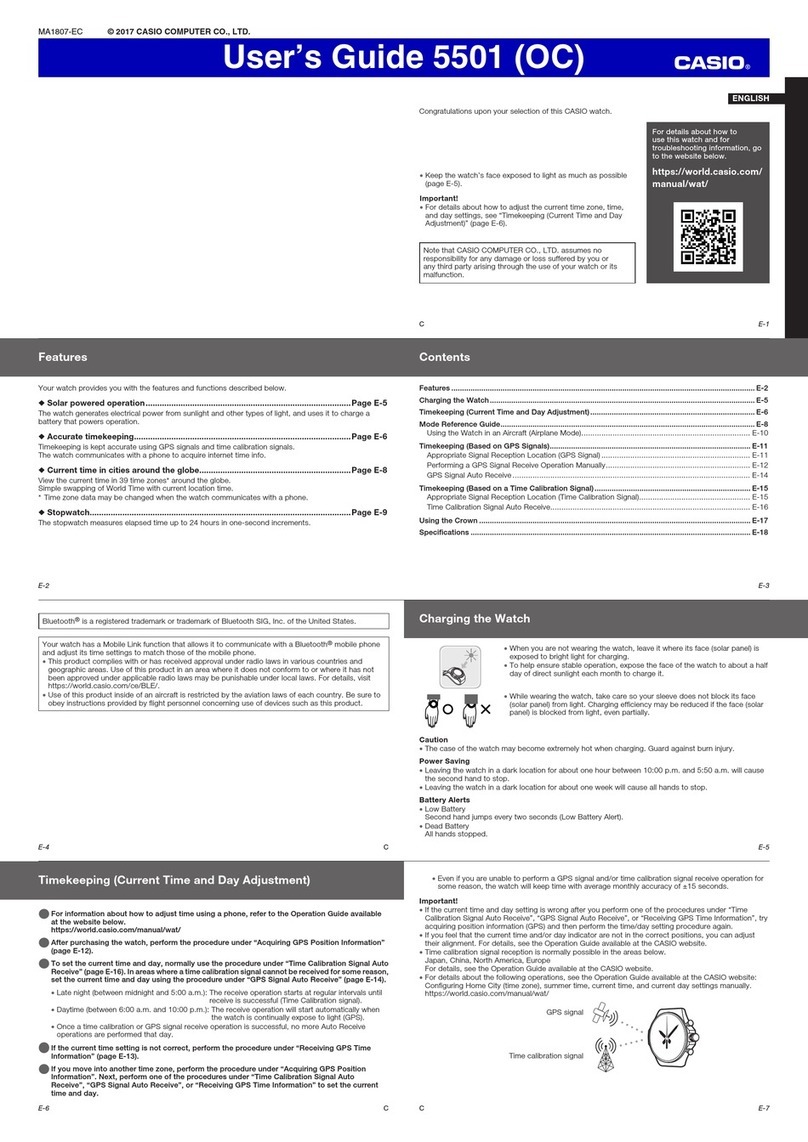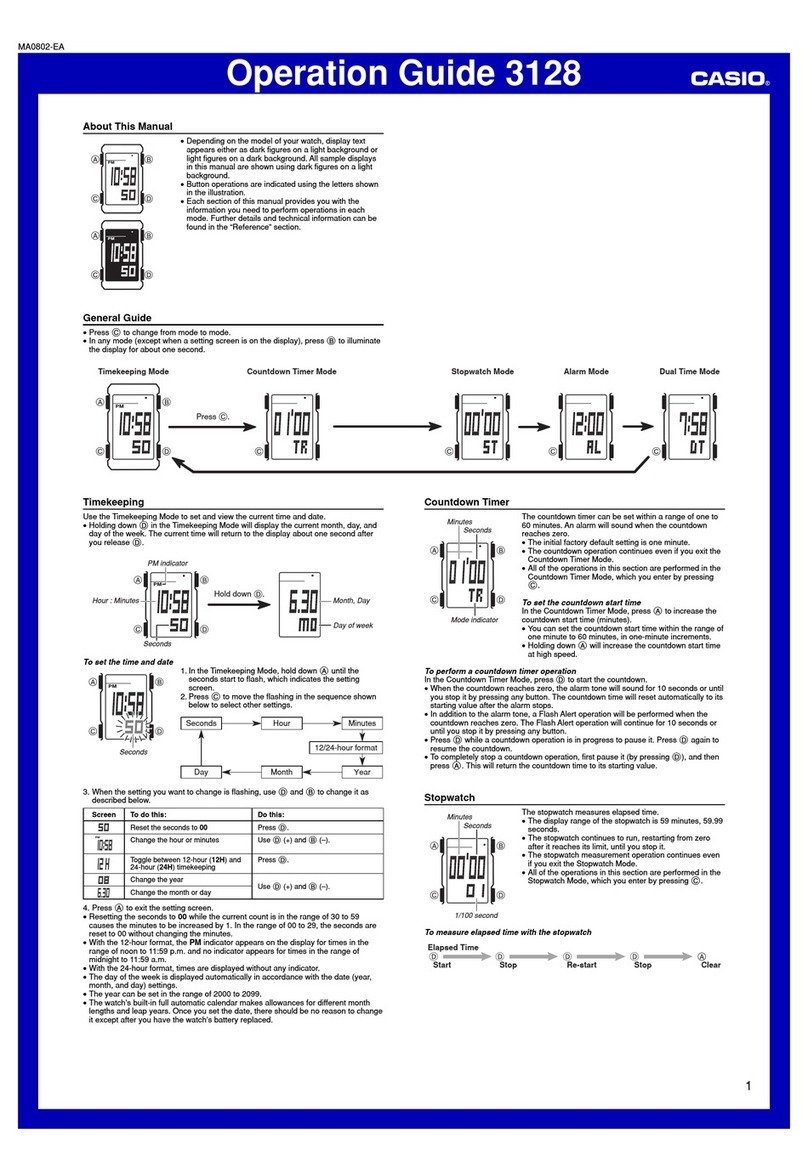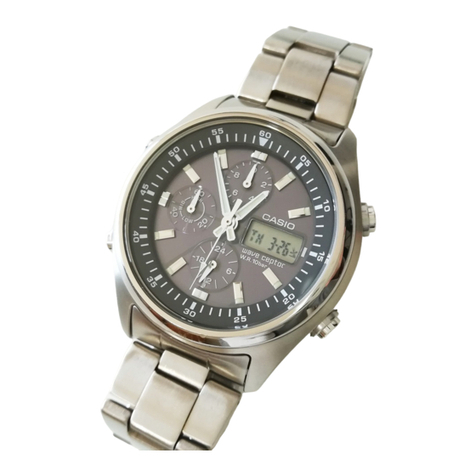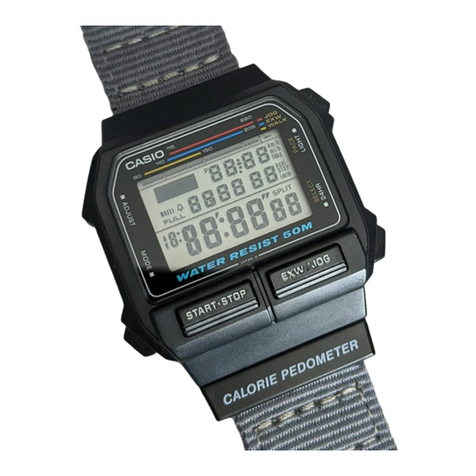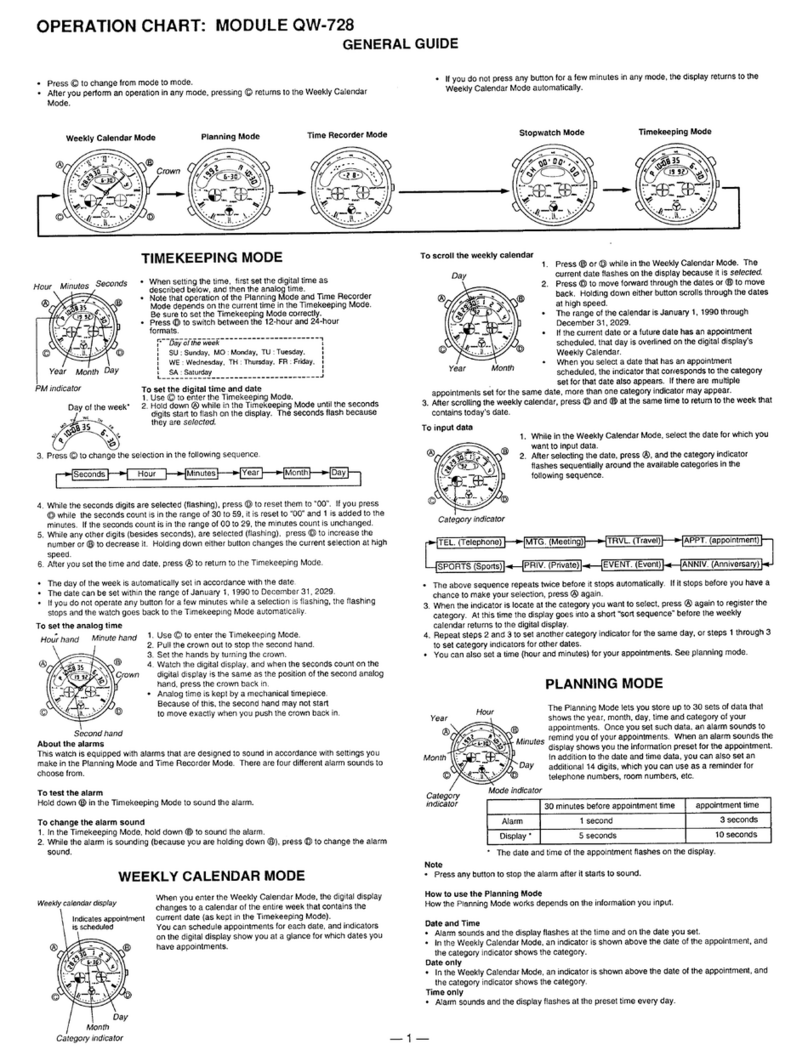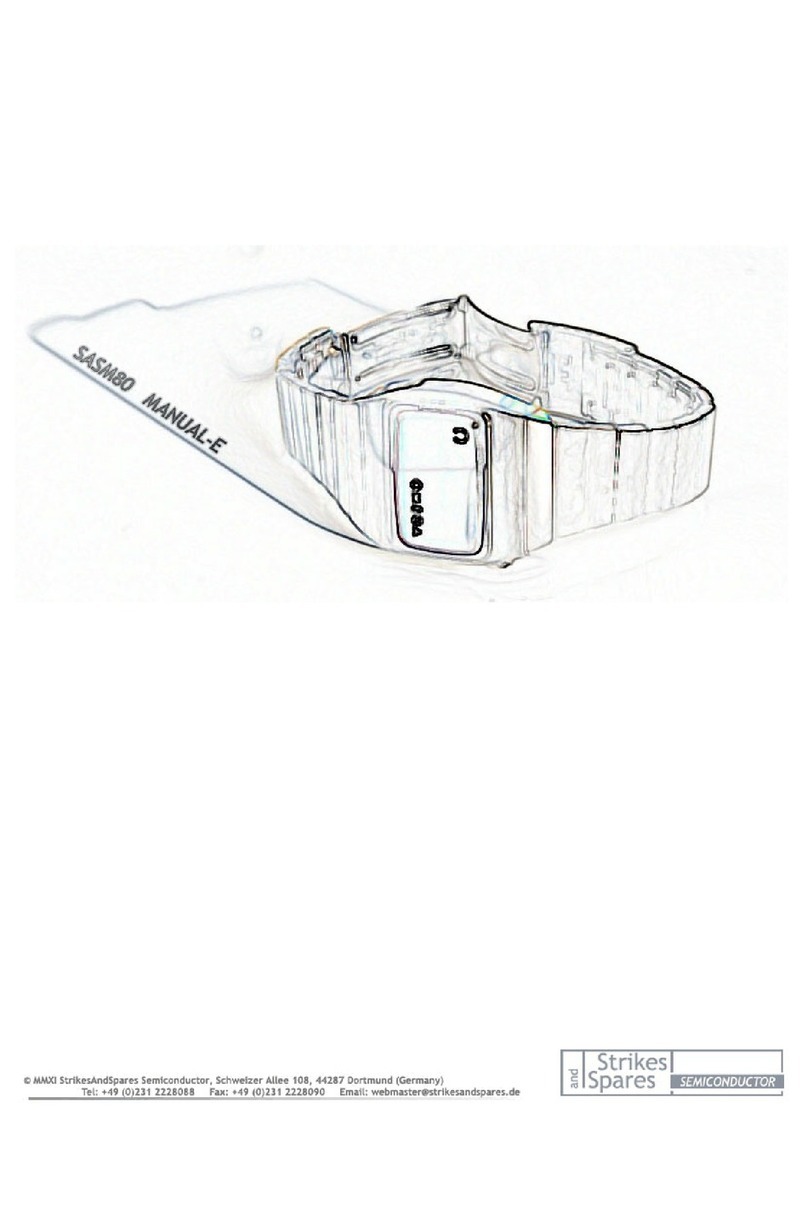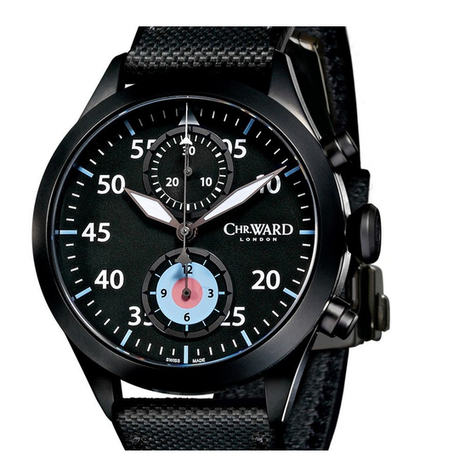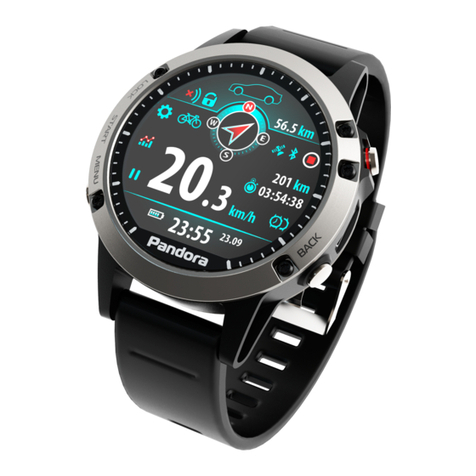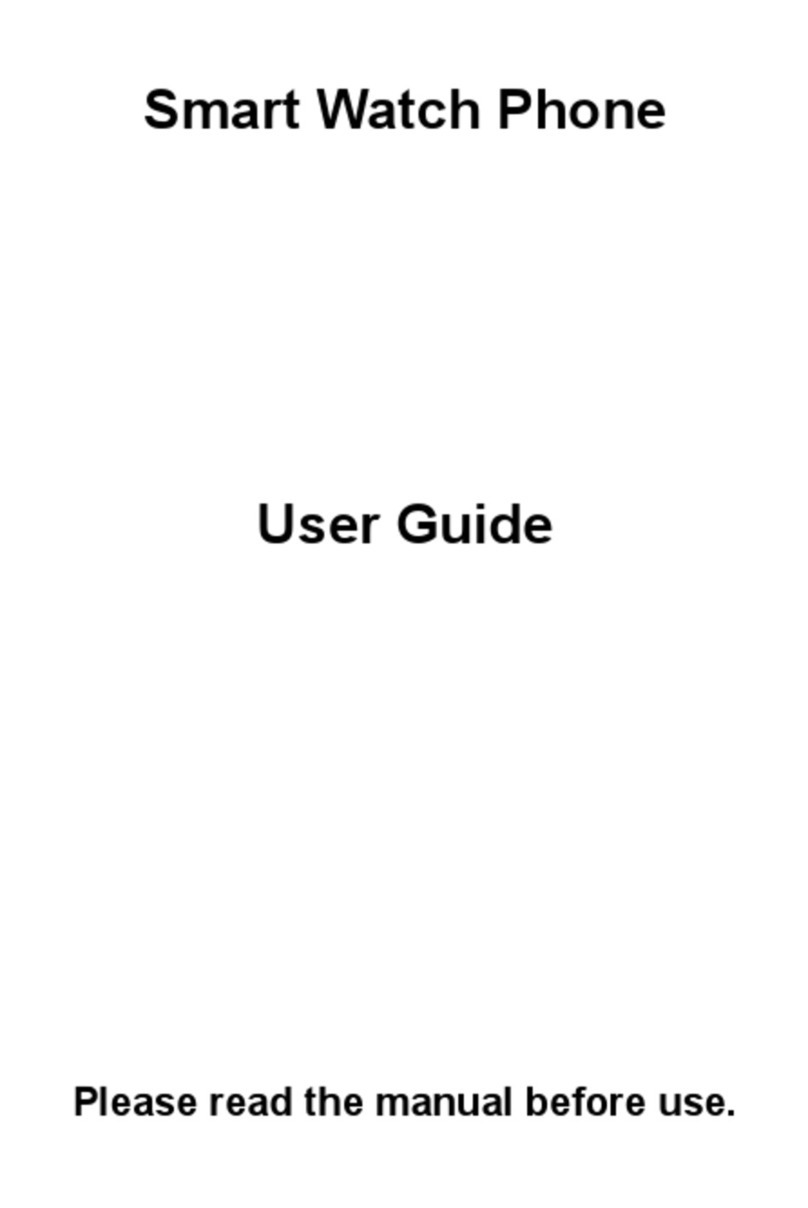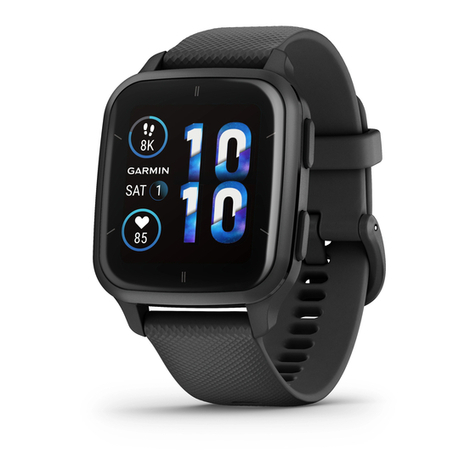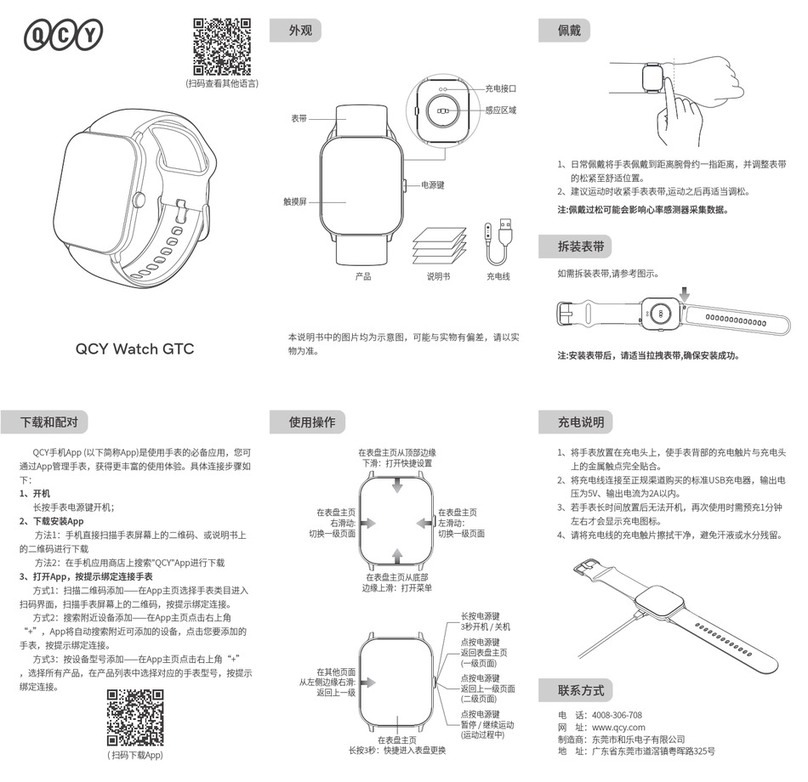
— 3 —
Auto light
switch on indicator
Moving the watch to a position that is parallel to the ground and then tilting it
towards you more than 40 degrees causes the backlight to illuminate.
ABOUT THE BACKLIGHT
About the Auto Light Switch
When the auto light switch is turned on, the backlight automatically turns on for two
seconds under the conditions described below. Avoid wearing the watch on the inside
of your wrist. Doing so causes the auto light switch to operate when not needed,
which shortens battery life.
Parallel to ground 40
°
More than
Parallel to ground
More than 15 degrees too high More than 15 degrees too low
New Moon Crescent
Moon Half Moon
First Quarter Full Moon Half Moon
Last Quarter
To display the moon up and moon down time for a specific date
•The moon data for your home (Timekeeping Mode)
point appears first when you enter the Moon Data Mode.
•Press E(forward) or B(back) within about two
seconds after entering the Moon Data Mode to scroll to
another point. It takes a few minutes before moon data
appears after you display the name of a point.
•If you do not perform any button operation, about two
seconds after you enter the Moon Data Mode the
display changes automatically to show the moon data
for today’s date. Pressing Eadvances to the next date,
while Bgoes back to the previous date. Holding down
either button scrolls the date at high speed. It takes a
few minutes before moon data appears after you display
a date.
Point name
Month Day
Moon age
Moon down time
Moon up time
Year
Month
Day
High Ebb Flood High
Tide graph Time
Low
The black bar on the tide graph indicates
the current tide.
Month - Day
Point name
Day
Sunset time Sunrise time
Month
•The backlight may not illuminate if the face of the watch is more than 15 degrees off
parallel to the left or right. Make sure that the back of your hand is parallel to the
ground.
•Static electricity or magnetic force can interfere with proper operation of the auto
light switch function. If the backlight does not illuminate, try moving the watch back
to the starting position (parallel with the ground) and then tilt it back toward you
again. If this does not work, drop your arm all the way down so it hangs at your side,
and then bring it back up again.
•Under certain conditions the backlight may not light until about one second after you
turn the face of the watch towards you. This does not necessarily indicate
malfunction of the backlight.
To turn the auto light switch on and off
In the Timekeeping Mode, hold down Efor one or two seconds to turn the auto light
switch function on and off.
Hold down E
.
ON OFF
•The auto light switch indicator is shown on the display in all modes while the auto
light switch is on.
•In order to protect against running down the battery, the auto light switch is
automatically turned off approximately six hours after you turn it on. Repeat the
above procedure to turn the auto light switch back on if you want.
•Pressing D(Timekeeping Mode, Moon Data Mode, Tide Graph Mode, Sunrise/
Sunset Mode, Alarm Mode) or E(Countdown Timer Mode, Stopwatch Mode)
illuminates the display, regardless of the auto light switch’s on/off setting.
Caution
•The backlight of this watch employs an electro-luminescent (EL) light, which loses
its illuminating power after very long term use.
•Frequent use of the backlight shortens the battery life.
•The watch may emit an audible sound whenever the display is illuminated. This is
due to vibration of the EL panel used for illumination, and does not indicate
malfunction.
Warning!
•Never try to read your watch when mountain climbing or hiking in areas that
are dark or in areas with poor footing. Doing so is dangerous and can result in
serious personal injury.
•Never try to read your watch when running where there is the danger of
accidents, especially in locations where there might be vehicular or
pedestrian traffic. Doing so is dangerous and can result in serious personal
injury.
•Never try to read your watch when riding on a bicycle or when operating a
motorcycle or any other motor vehicle. Doing so is dangerous and can result
in a traffic accident and serious personal injury.
•When you are wearing the watch, make sure that its auto backlight function is
turned off before riding on a bicycle or operating a motorcycle or any other
motor vehicle.
Sudden and unintended operation of the auto backlight can create a
distraction, which can result in a traffic accident and serious personal injury.
MOON DATA MODE
Be sure to set the current time and your current location before trying to use the Moon
Data Mode.
The Moon Data Mode display shows the current moon age, as well as moon up and
moon down times. Moon age is indicated both by a value and one of the following
graphics.
•The light part of the moon graph shows the part of the Moon that is visible in the sky
during each particular phase.
•The moon graph shows the Moon as viewed at noon from a position in the Northern
Hemisphere looking south. Note that at times the image shown by the moon graph
may differ from that of the actual Moon in your area.
•The left-right orientation of the Moon phase is reversed when viewing from the
Southern Hemisphere or from a point near the equator.
•The moon up time indicates when the moon will
reach its highest point relative to your current
location (upper transit), while the moon down time
indicates when it will reach its lowest point (lower
transit). Note that moon up and moon down times
are accurate up to ±30 minutes.
Moon Moon-Up
Earth
Location
Moon Moon-Down
•Note that once the moon data display appears, you
cannot change to another point. To change to another
point, press Atwice to return to the point name display
and make the changes you want.
•Moon data is displayed in 5-minute units.
•For days around the full moon (moon age 15) or new
moon (moon age 29.5), there are days where there is
no moon up or moon down. In such cases, the xx:xx
is shown for the moon up or moon down time.
TIDE GRAPH MODE
1.Press Awhile in the Moon Data Mode to enter the
Tide Graph Mode. The display shows the tide graph for
6:00 am on the date that was selected in the Moon
Data Mode.
2.Use E(forward) and B(back) to scroll the time in
1-hour increments. Holding down either button changes
the time at high speed.
•Note that once you enter the Tide Graph Mode, you
cannot change to another point or date. To change to
another point or date, press Ato return to the Moon
Data Mode, make the changes you want, and then
reenter the Tide Graph Mode.
SUNRISE/SUNSET MODE
•The today’s sunrise and sunset data for the point
currently selected in the Moon Data Mode appears first
when you enter the Sunrise/Sunset Mode.
•Press E(forward) or B(back) within about two
seconds after entering the Sunrise/Sunset Mode to
scroll to another point. It takes a few minutes before
sunrise/sunset data appears after you display the name
of a point.
•If you do not perform any button operation, about two
seconds after you enter the Sunrise/Sunset Mode the
display changes automatically to show the sunrise/
sunset data for today’s date. Pressing Eadvances to
the next date, while Bgoes back to the previous date.
Holding down either button scrolls the date at high
speed. It takes a few minutes before sunrise/sunset
data appears after you display a date.
•Note that once the sunrise/sunset data display appears, you cannot change to
another point. To change to another point, press Ato return to the point name
display and make the changes you want.
•Sunrise/sunset data is displayed in 5-minute units.
COUNTDOWN TIMER MODE
The countdown start time can be set within a range of 1 second to 24 hours. When
the countdown reaches zero, an alarm sounds.
To set the countdown start time and to switch auto repeat timing on and off
1.Hold down Awhile in the Countdown Timer Mode.
The minute’s digits flash on the display because they
are
selected
.
2.Press Cto change the selection in the following
sequence.
Minutes
Auto repeat on/off
Seconds Hours
3. While the hour, minutes, or second’s digits are flashing, press Eto increase the
value or Bto decrease it. Holding down either button changes the value at high
speed.
•To set the starting value of the countdown time to 24 hours, set 0:00 00.
4. While the auto repeat indicator is flashing, press Etoggle auto repeat on and off.
The auto repeat indicator is on the display only while you are setting the countdown
start time. Press E.
Auto repeat OFF Auto repeat ON
5. After you set the countdown start time and auto repeat timing on and off, press A
to return to the Countdown Timer Mode.
Hours : Minutes Seconds

